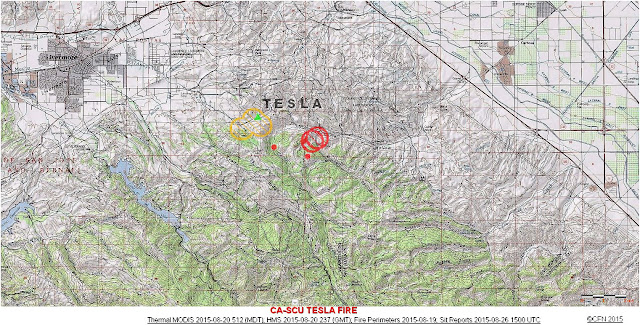Yosemite Fire Update #13, August 21, 2015
Currently no roads are closed within the park.
Upper (37 45.534 x 119 35.983 – Mariposa Co., August 10). This fire was discovered by hikers at approximately 3:30PM, August 10. It is now out and in patrol status. Quick action by the Yosemite Helitack, with supporting water bucket drops, and fire crews held the fire to 3.85 acres. The fire was determined to be human caused and is under investigation. Smoke from the fire may continue to affect air quality in the morning hours. All park trail closures associated with the Upper Falls fire were lifted at 6:00 PM 8/13.
Badger (37 40.697 x 119 39.316 – Mariposa Co., August 10). This fire was discovered by Helicopter 551 in the area of Summit Meadows near Glacier Point Road. Wawona Engine 32 responded and suppressed the 0.01acre fire. It is in patrol status.
Lightning caused fires being monitored and managed for multiple objectives:
Cathedral (37 51.078 x 119 25.120 – Tuolumne Co., 9400’El., 8/2). This is near the John Muir Trail to Cathedral Lakes. The perimeter is actively smoldering and creeping through lodgepole pine needles and logs and has good potential to grow until it hits natural barriers. The fire is 16 acres in size and is being monitored.
Middle (37 51.538 x 119 41.194 - Tuolumne Co., 8043’El., 7/27). It is west of White Wolf and south of the Middle Tuolumne River. It is at 14.1 acres, and smoke may be visible from Tioga Road. It continues to smolder and creep through down logs, pine needles and other vegetation. It is in a red fir and lodgepole pine forest.
Dark (37 50.575 x 119 37.153 – Mariposa Co.,8200’ el., 7/ 9). This fire is along the Yosemite Creek Campground Road and smoke is periodically visible from both the campground and Tioga roads. Fire crews secured the edges of the fire by burning along the most active perimeter. That operation is complete. It is at 40 acres, and continues to creep and smolder through red fir duff and needles within the interior of the fire. The Lukens trail is now re-opened. Fire crews will be parked and working Yosemite Creek Campground Road. For firefighter and visitor safety, drivers are urged to use caution while driving in the area of parked fire equipment.
White Cascade (37 54.926 x 119 23.780 - Tuolumne Co, at 9000’ el., 7/3). This remote fire is east of Glen Aulin High Sierra camp, east of Conness Creek, and west of Tuolumne Meadows, and is at 8 acres. This high elevation fire, in a lodge pole pine forest, has a low spread potential. The fire is not near any trails. Smoke may be visible in Tuolumne Meadows.
Quartzite (37 43.871 x 119 25.200 - Mariposa Co., 8387’ el., 7/27). It is approximately 0.5 miles south of Merced Lake, mid-slope and on a north aspect. It is smoldering in mountain hemlock, western white pine and lodgepole pine. This fire is contained to natural barriers.
Stubblefield (38 02.743 x 119 36.625 – Tuolumne Co., 7659’ el., 8/3). This fire is in Stubblefield Canyon and west of the Pacific Crest Trail and at the northeast section of the Park; it is very remote. It is most likely a lightning strike holdover. Currently, it is 2 acres in size, in a red fir and Jeffrey Pine forested area, with other sparse vegetation.
Air Quality in the park is being affected by numerous fires throughout California. For more information refer to the web sites listed below. Currently no roads are closed within the park.
All visitors are urged to be diligent in any use of fire, including smoking. And be sure all fires are out!
As with all fires, staff and visitor safety is of paramount importance. Each fire, regardless of size, is assessed for the appropriate course of action.
For More Information
Nixle - Emergency Alerts and Updates– www.nixle.com
Photo credit: Wikipedia Commons













